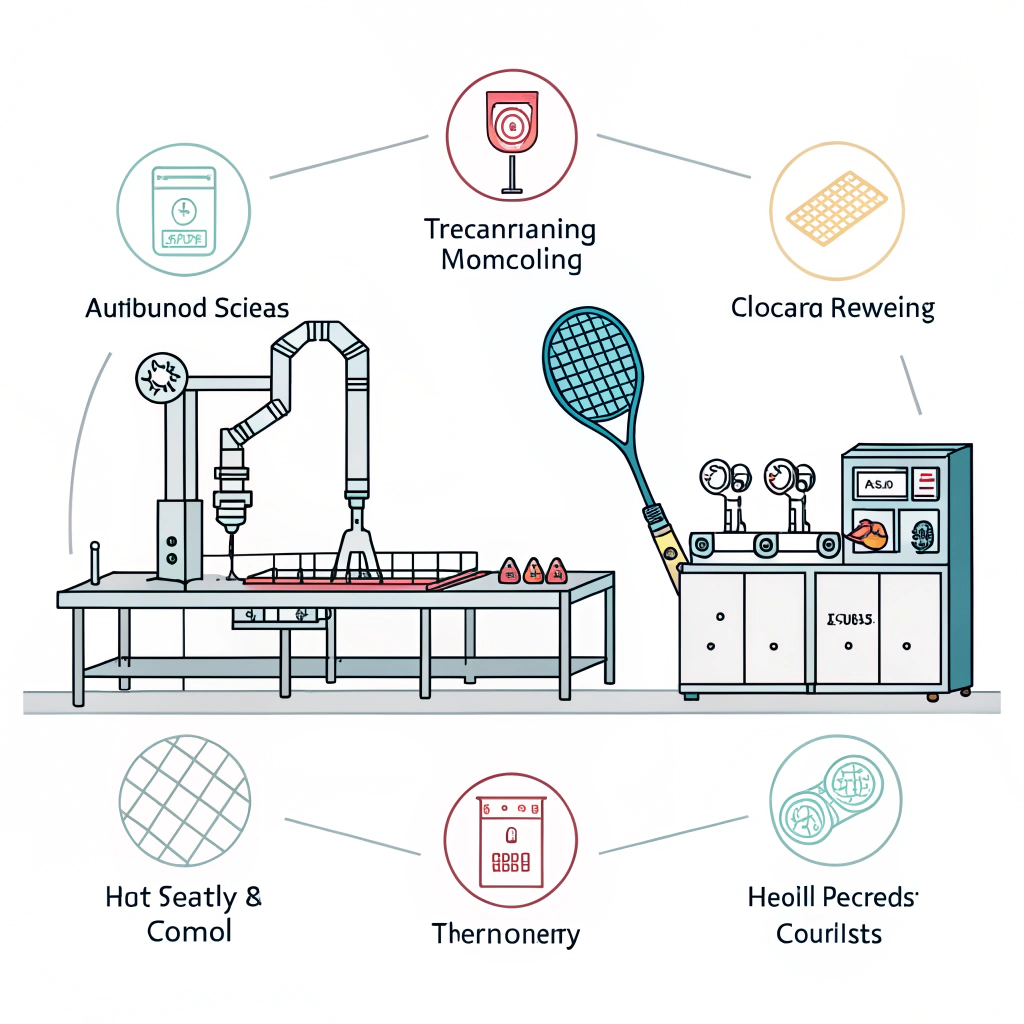Optimizing production lead times in pickleball paddle manufacturing means choosing the right process, managing quality control, and streamlining your supply chain. In this article, we explore actionable strategies that minimize lead times while ensuring consistent, high-quality outputs.
In today’s competitive sports equipment market, production lead time is a critical factor that procurement managers, operations directors, and supply chain decision-makers must address. Long lead times can hinder responsiveness to market demand, delay order fulfillment, and ultimately impact customer satisfaction. For businesses like NEX Pickleball that manufacture high-performance pickleball paddles, reducing production cycle times is key to meeting market expectations and maintaining a competitive edge.
Many high-volume manufacturers in the sports equipment industry face the challenge of balancing production efficiency and product quality. Specifically, in pickleball paddle manufacturing, factors such as material selection, processing methods, and quality control directly influence production lead times. The modern manufacturing environment necessitates a data-driven approach to optimize every step of the production process.
Key issues include:
- Lengthy production cycles due to inefficient processing methods.
- Inadequate quality control protocols that lead to rework or wastage.
- Trade-offs between material properties and production speed.
- Supply chain dependencies that can introduce unforeseen delays.
By understanding these challenges, manufacturers can implement targeted strategies to optimize production lead times, cut unnecessary delays, and improve overall production efficiency.
Reducing lead times starts with identifying the factors that slow production. The following three elements typically contribute to longer production cycles:
-
Production Methods:
NEX Pickleball employs three main production processes—hot pressing, cold pressing1 and thermoforming2. Each method has distinct advantages and inherent limitations that affect both the production speed and the final product quality. -
Material Characteristics:
The choice of materials such as 3K Carbon Fiber3, 12K Carbon Fiber, and various composite combinations strongly influences the overall production timeline. Materials that require specialized handling or prolonged curing times can slow the process considerably. -
Quality Control Protocols:
Balancing speed with quality means investing in rigorous testing procedures. Often, the time spent in quality control is proportional to the complexity of the product. Delays in detecting defects can lead to batch rework, thereby extending lead times.
A detailed comparison of the three primary manufacturing processes highlights the trade-offs between speed and quality. The table below summarizes key factors for each process:
| Production Process | Advantages | Disadvantages | Impact on Lead Time |
|---|---|---|---|
| Hot Pressing | - High production efficiency - Excellent impact resistance - Strong structural integrity |
- May alter material properties - Requires high investment - Faster cycle may compromise finishing touch |
Generally shorter lead times when high-volume production is needed |
| Cold Pressing | - Precise control over thickness - Maintains original material properties - Excellent ball feel |
- Longer production cycles - High dependence on machinery precision |
Moderate lead times with improved product feel and control |
| Thermoforming | - Enables intricate designs - Precise material distribution - Superior paddle stability |
- Long production time - Expensive setup - Best for premium or custom orders |
Typically longer lead times, suitable for tailored, high-end products |
From this comparison, it is evident that while hot pressing may offer faster production cycles, it might not always yield the tactile performance required for players. Cold pressing and thermoforming, in contrast, provide better control and customization options but require more time. The selection of the process depends on the specific needs of the product and market segment.
Based on our analysis, manufacturers can apply several actionable strategies to optimize lead times without sacrificing quality:
-
Process Selection and Standardization
Evaluate the performance requirements of your paddle products and match them with the appropriate production method. For large-scale orders where speed is paramount, hot pressing offers a compelling balance between efficiency and performance. However, for custom or premium products, processes like cold pressing or thermoforming are preferable despite their longer cycle times. Standardizing these processes across production lines can also help in reducing setup changes and the potential for error. -
Material Optimization
Choose materials that meet performance criteria but also allow for rapid processing. For instance, selecting composites that combine carbon fiber and fiberglass can provide the desired performance characteristics while enabling a faster production cycle. Ensure that the chosen materials are compatible with the selected production process to maintain quality and reduce rework risks. -
Advanced Quality Control Integration
Integrate real-time quality monitoring systems throughout the production process. Automation and data-driven inspection methods can significantly reduce the time spent on quality control steps. Equipping production lines with sensors and high-speed cameras for defect detection can help identify issues early, minimizing the need for time-consuming rework. -
**Production Process automation technologies4
Investing in automation technologies helps in standardizing production processes, reducing human error, and accelerating production cycles. Automated machinery, especially those capable of handling complex processes like thermoforming, can improve consistency and reduce cycle times. Synchronizing these tools with supply chain management systems ensures that any deviations are addressed swiftly. -
**Lean manufacturing techniques5
Implement lean manufacturing principles to eliminate waste and unnecessary steps. Streamline operational workflows and use just-in-time (JIT) production methods to ensure that inventory levels are optimized, reducing storage waste and production delays. Establish a continuous improvement framework where production teams constantly analyze and refine their processes. -
Cross-Department Collaboration
Encourage close collaboration between engineering, production, and supply chain teams. When everyone has a common understanding of performance goals and the constraints of each production process, teams can work together to avoid miscommunications that often lead to delays. Regular meetings and integrated project management tools can foster efficient coordination.
At NEX Pickleball, we have successfully reduced lead times by implementing an optimized blend of production processes and operational strategies:
-
Targeted Production Process Selection:
For bulk orders, our manufacturing lines utilize hot pressing to achieve rapid production without compromising paddle strength. Meanwhile, our custom orders benefit from cold pressing techniques that prioritize ball control and product ergonomics. -
Data-Driven Quality Control:
We integrate automated quality control systems that continuously monitor product dimensions, material integrity, and finishing quality. This proactive approach ensures that defects are caught early, thereby avoiding potential delays later in the production cycle. -
Efficient Material Use:
By carefully selecting high-performance materials like 3K and T300 Carbon Fiber for speed and durability, we streamline the production process. Additionally, our combination of composite materials provides not only performance advantages but also faster processing times, allowing us to serve both high-end and mass-market segments effectively. -
Lean Process Implementation:
Lean manufacturing techniques have been thoroughly integrated into our operations. This includes optimizing workflow layouts, reducing waste in production, and employing rigorous timing and performance metrics to continuously fine-tune our processes.
Tables and charts summarizing our production efficiency improvements and lead time reductions are often used in internal reviews, emphasizing the impact of these measures on our overall operational performance.
While optimizing lead times is essential, decision-makers must consider several key factors:
-
Quality vs. Speed:
Faster production should not lead to a compromise in quality. It is crucial to strike a balance between reducing cycle times and maintaining the high-performance attributes that players expect. Always assess whether a shortened lead time might affect the paddle’s response, ball control, or durability. -
Custom vs. Mass Production:
For businesses relying on mass production, efficiency is critical. However, custom paddle solutions designed for unique player requirements may naturally require longer production cycles. Evaluating market demands and aligning production processes accordingly is vital. -
Investment Requirements:
Upgrading to automation and advanced quality control systems involves a significant upfront investment. Decision-makers need to balance the cost against long-term savings and efficiency improvements. -
Supplier and Material Reliability:
A well-managed supply chain not only reduces lead times but also ensures consistency in material quality. Engaging with reliable suppliers and establishing contingency plans for unexpected delays can greatly enhance production stability.
A summarized list of considerations is presented below:
| Consideration | Impact on Production Lead Times | Mitigation Strategy |
|---|---|---|
| Quality vs. Speed | Overly rapid production may hurt quality | Implement parallel quality control |
| Custom vs. Mass Production | Custom orders demand longer cycle times | Use process standardization where possible |
| Investment in Automation | Upfront costs may be high | Evaluate ROI over long production cycles |
| Supplier Reliability | Inconsistent supplies can delay production | Build strong supplier partnerships |
Reducing production lead times in pickleball paddle manufacturing requires a multifaceted approach. The key is to align production processes with market demands while ensuring that quality remains uncompromised. By standardizing production methods, optimizing materials, automating quality control, and implementing lean techniques, manufacturers can achieve significant improvements in efficiency.
For procurement managers and operations directors, the insights shared in this article provide a framework for evaluating potential manufacturing partners or for improving in-house processes. Here are the final recommendations:
• Evaluate your current production processes and identify which stage contributes most to extended lead times.
• Invest in process automation and real-time quality control to catch defects early.
• Maintain a balance between speed and customization by standardizing processes where possible.
• Develop a strong relationship with suppliers to minimize the risks of delays.
• Continuously monitor production metrics and adjust workflows to further streamline operations.
By taking these steps, businesses can not only reduce cycle times but also maintain the high standards needed for competitive, high-performance paddle manufacturing.
People Also Ask
-
What are the main strategies for reducing lead time in pickleball paddle manufacturing?
Answer: Strategies include selecting the appropriate production process (such as hot pressing for high-volume, cold pressing or thermoforming for customized products), integrating real-time quality control, leveraging automation, and implementing lean manufacturing techniques. -
How do production processes like hot pressing, cold pressing, and thermoforming affect production efficiency and paddle quality?
Answer: Hot pressing offers efficiency and strong structural integrity, cold pressing provides precise control and material consistency, while thermoforming enables intricate designs. Each process has trade-offs in cycle time, customization, and material impact that must be carefully balanced to meet quality requirements. -
How important is quality control in optimizing production lead times for paddle manufacturing?
Answer: Quality control is critical as it prevents rework and waste. Implementing automated, data-driven systems ensures that defects are detected early, reducing delays and preserving the balance between rapid production and exceptional paddle performance.
-
Cold Pressing: Click to read about the cold pressing process, its precision in controlling material thickness, and how it helps maintain the original properties of materials for enhanced product feel. ↩ ↩
-
Thermoforming: Click to learn more about thermoforming, an advanced manufacturing process known for enabling intricate designs and precise material distribution in high-end production applications. ↩ ↩
-
3K Carbon Fiber: Click to explore the characteristics of 3K Carbon Fiber, including its lightweight strength and impact on production timelines, essential for achieving high performance in advanced composite materials. ↩ ↩
-
Automation Technologies: Click to discover how automation technologies streamline manufacturing processes by reducing human error and increasing production speed, vital for modern production environments. ↩ ↩
-
Lean Manufacturing Techniques: Click to understand lean manufacturing techniques, a methodology focused on waste elimination and continuous process improvement to optimize production efficiency. ↩ ↩







